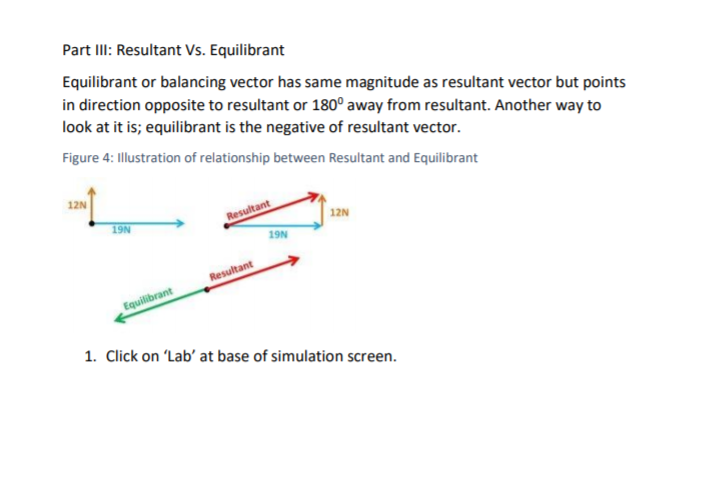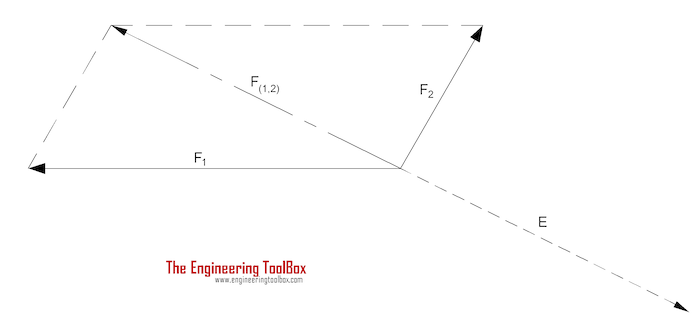Difference Between Resultant And Equilibrant Vector
Equilibrant is the negative of resultant vector. The difference between a resultant and equilibrant vector is that resultant vector is a direct quantity one with both magnitude and direction while the equilibrant vector is a force equal to but opposite of the resultant sum of vector forces that.

Resultant And Equilibrant Forces Dutable
As nouns the difference between vector and equilibrant is that vector is mathematics a directed quantity one with both magnitude and direction.

Difference between resultant and equilibrant vector. 0 degrees at north 90 east 180 south 270 west. The equilibrant vector brings the sum of all vectors to zero. The difference between a resultant and equilibrant vector is that resultant vector is a direct quantity one with both magnitude and direction while the equilibrant vector is a force equal to but opposite of the resultant sum of vector forces that force which balances other forces thus bringing an object to equilibrium.
The notation is shown below. The resultant force is kind of like the total of all vectors and the equilibrant is 180 degrees around and is the force that would balance the resultant a. Calculating resultant and equilibrant vectors About Press Copyright Contact us Creators Advertise Developers Terms Privacy Policy Safety How YouTube works Test new features 2021 Google LLC.
Resultant is a single force that can replace the entire system of forces both in magnitude and in direction. Resultant net force causes the displacement of a body ie. Equilibrant keeps the body at rest ie.
The difference between a resultant and equilibrant vector is that resultant vector is a direct quantity one with both magnitude and direction while the equilibrant vector is a force equal to but opposite of the resultant sum of vector forces that force which balances other forces thus bringing an. The set of forces which causes the displacement of a body are called as component of resultant or component forces. MCV 4U 81 Vectors as Forces Done1notebook 5 May 03 2018 Just like with vectors in Chapter 6 we can use a parallelogram or a triangle to determine the resultant and equilibrant vectors when two or more forces are combined if they are not collinear.
Two vectors A and B are. The signed difference between two points while equilibrant is a force equal to but opposite of the resultant sum of vector forces. For example if the.
Equilibrant or balancing vector has same magnitude as resultant vector but points in direction opposite to resultant or 1800 away from resultant. Another way to look at it is. Difference between resultant and equilibrant in.
Difference Between Resultant and Equilibrant In. The resultant force is kind of like the total of all vectors and the equilibrant is 180 degrees around and is the force that would balance the resultant a perfect example is a force table. The 7 Main ApproachesPerspectives to Psychology Many psychologists may believe that each perspective has valid explanations depending on the specific situation and this point of view is called eclectic.
The point of action and the direction of action of the resultant vector determine the torque. Find an answer to your question What is the difference between the equilibrium vector and the resultant vector nancyayomide nancyayomide 09072020 Physics College What is the difference between the equilibrium vector and the resultant vector 1 See answer. Resultant is a single force that can replace the effect of a number of forcesEquilibrant is a force that is exactly opposite to a resultantEquilibrant and resultant have equal magnitudes but opposite directions.
Which indicate the displacement these vector by a single vector. Science Submitted By kathleenpascual Words 700 Pages 3. R A B C The equilibrant vector is the vector that make the system in.
The resultant vector is the combination vector of number of different vector in space. That force which balances other forces thus bringing an object to equilibrium. That single vector is resultant vector.
Resultant has the same effect on the body as all the forces put together that acts on the system. It balances with all the vectors and its magnitude is equal to the resultant vector but just opposite in direction. Illustration of relationship between Resultant and Equilibrant Click on Lab at base of simulation screen.
The resultant is a trigonometric function usually using the Law of Cosines in two dimensional solution by vector resolution of two or more known forces while equilibrant is equal in. The difference between a resultant and equilibrant vector is that resultant vector is a direct quantity one with both magnitude and. Whats the difference between resultant and Equilibrant vector The difference between a resultant and equilibrant vector is that resultant vector is a direct quantity one.

Finding And Drawing An Equilibrant Showmethephysics Com Youtube

Calculating Resultant And Equilibrant Vectors Youtube
Https Www Tecumseh K12 Oh Us Downloads Physics 6 13 Pdf
Http Www Tecumseh K12 Oh Us Downloads Physics 6 3 Pdf

Part Iii Resultant Vs Equilibrant Equilibrant Or Chegg Com

Resultant And Equilibrant Forces Dutable

Statics Equilibrant The Condition Of Equilibrium How To Solve Example Whiteboards Demo Force Scales Masses Ppt Download

Aim How Do We Add Force Vectors What Is An Equilibrant Vector Do Now Sam And Joey Are Fighting Over A Toy Sam Pulls With A Force Of 30n To The Left

What Are The Equilibrium Of Forces And Resultant Force Firstalert In

Htpib09b Finding The Equilibrant Youtube
What Is The Difference Between Resultant And Equilibrum Quora

How Find Equilibrant Mathematics Stack Exchange

The Equilibrant Vector Youtube

Equilibrant Of Three Forces In Three Dimension Vectors Resultant And Equilibrium Youtube

Moment Vs Couple I Coplaner Non Concurent Forces I Mechanics Of Solids I Lect 29 Youtube In This Moment Engineering Mechanic


Posting Komentar untuk "Difference Between Resultant And Equilibrant Vector"